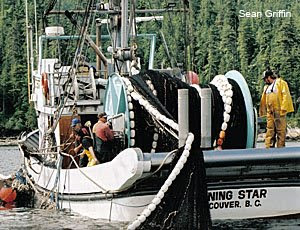 However, recent research on species evolution has thrown these practices into question: now, it seems, we need those big, old, fat fish to sustain our seas. Research indicates that removing larger, older individuals of a population, especially reproducing females, may actually undermine stock replenishment. Larger, older females often produce significantly more and stronger offspring than the smaller ones. "The larvae of these older females may also be larger, with greater fat reserves that can aid growth and survival [...] Older females can also have earlier and/or longer spawning seasons than younger, smaller females, and the fact of their longer lives may allow them to outlive periods of low larval recruitment." [1] This idea has come to be known as the BOFFFF (Big Old Fat Fecund Female Fish) hypothesis, developed by Steven Berkeley at the University of California at Santa Cruz with his study of Pacific rockfish.
However, recent research on species evolution has thrown these practices into question: now, it seems, we need those big, old, fat fish to sustain our seas. Research indicates that removing larger, older individuals of a population, especially reproducing females, may actually undermine stock replenishment. Larger, older females often produce significantly more and stronger offspring than the smaller ones. "The larvae of these older females may also be larger, with greater fat reserves that can aid growth and survival [...] Older females can also have earlier and/or longer spawning seasons than younger, smaller females, and the fact of their longer lives may allow them to outlive periods of low larval recruitment." [1] This idea has come to be known as the BOFFFF (Big Old Fat Fecund Female Fish) hypothesis, developed by Steven Berkeley at the University of California at Santa Cruz with his study of Pacific rockfish.
There are now studies that show how removing BOFFFFs and other large adults from our oceans can result in evolutionary changes over time. A recent New York Times article discusses how human acts of selection run counter to the acts of selection found in nature:
Predators typically take “the newly born or the nearly dead,” Dr. Darimont said. For predators, targeting healthy adults can be dangerous, and some predator fish cannot even open their mouths wide enough to eat adult prey. Animals raised as livestock are typically slaughtered relatively young, he said, and farmers and breeders retain the most robust and fertile adults to grow their herds or flocks.
But commercial fishing nets and other gear that comply with conservation regulations typically trap large fish while letting smaller ones escape. Trophy hunters typically seek out the largest animals. And for some fish in some areas, as much as 50, 60 or even 80 percent of the stock may be caught every year.
“Targeting large, reproducing adults and taking so many of them in a population in a given year — that creates this ideal recipe for rapid trait change,” Dr. Darimont said.
There still needs to be much more research done on the topic of fisheries-induced evolution, but as the initial studies show, big adult individuals might be a lot more important to our healthy oceans than we realize.





No comments:
Post a Comment